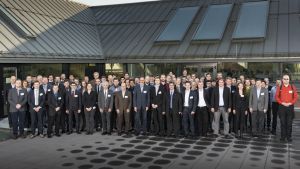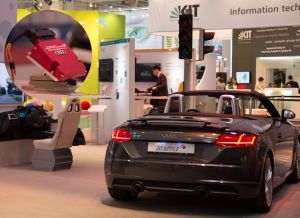Safety-critical applications in automobility, aviation, and industry 4.0 will require far more digital computation capacity in the future. This requirement can be met by multi-core technologies. Using demonstrators, the ARAMiS project coordinated by Karlsruhe Institute of Technology (KIT) proved that multi-core processors are suited in principle for safety-critical applications. On this basis, the ARAMiS II project was started recently to study and optimize development processes, development tools, and platforms for the efficient use of industrially available multi-core architectures.
The need for digital computation capacity is increasing enormously. This is also due to highly automated vehicles and interconnected machines with real-time capability, as well as to increasing integration and interaction with other products and services. Use of multi-core technologies allows to considerably increase the computation capacity of systems embedded in vehicles, aircraft, or industrial facilities. Multi-core processors have several processor cores that are run in parallel to reach a higher computation speed. In many applications, such as PCs, tablets, smartphones, they are already applied successfully. Safety-critical applications in mobility and industry, however, have to meet additional complex requirements.
“The new ARAMiS II project is aimed at developing indispensable methodological prerequisites to enhance the safety, efficiency, and comfort of using multi-core technologies and to make them available on the industrial scale. The results of ARAMiS II will be incorporated in standardization activities in the areas covered and supplied to other industry partners. This will maintain or increase the innovative power and international competitiveness of German products on important sales and growth markets,” Professor Jürgen Becker, Spokesperson of the Board of KIT’s Institute for Information Processing Technology (ITIV), explains. Together with Falco Bapp of ITIV, he coordinates ARAMiS II.
ithin the framework of the ARAMiS project, KIT, in cooperation with partners from research and industry, successfully demonstrated that multi-core technologies can be applied for and integrated into safety-critical applications in principle. On this basis, ARAMiS II will study, further develop, and optimize efficient development processes and in particular the systematic tool chain and industrial platforms for the reliable use of multi-core architectures. Demonstrators in the areas of automotive engineering, aviation, and industry automation will confirm applicability of the concepts and methods developed across all domains. During the kick-off meeting on December 01 and 02, 2016, all partners planned their next activities in these six partial projects: Application Cases and Requirements, Structured Multi-core Development, Multi-core Methods and Tools, Multi-core Platforms and Architecture Patterns, Implementation and Evaluation, Validation of Results and Exploitation.

The kick-off meeting for ARAMiS II took place in early December at KIT.
(Photo: Markus Breig/KIT)
The ARAMiS II consortium consists of 33 partners. Among them are renowned research institutions and leading automotive and aircraft manufacturers, manufacturers in the industry sector, supply companies, software and tool manufacturers. The industry partners are Continental, speaker of the industrial companies in ARAMiS II, Audi, Bosch, Airbus, Siemens, and others. The project is scheduled for a duration of three years. The project volume is above EUR 26 million. ARAMiS II is funded by the Federal Ministry of Education and Research (BMBF) with about EUR 15 million.
In close partnership with society, KIT develops solutions for urgent challenges – from climate change, energy transition and sustainable use of natural resources to artificial intelligence, sovereignty and an aging population. As The University in the Helmholtz Association, KIT unites scientific excellence from insight to application-driven research under one roof – and is thus in a unique position to drive this transformation. As a University of Excellence, KIT offers its more than 10,000 employees and 22,800 students outstanding opportunities to shape a sustainable and resilient future. KIT – Science for Impact.

